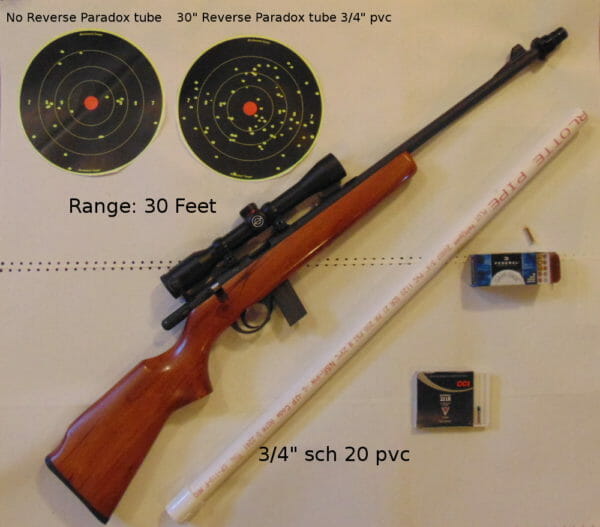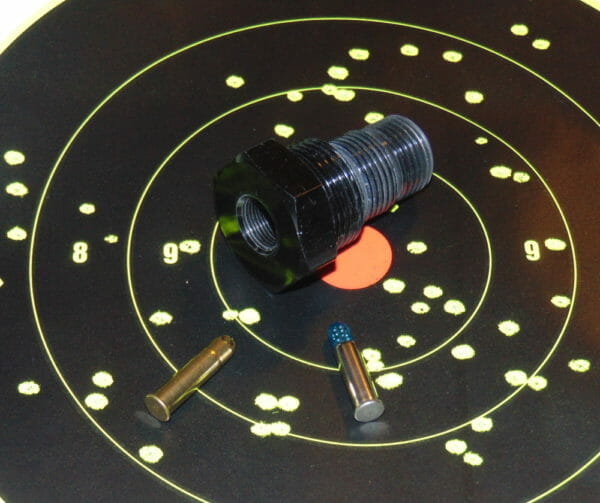WARNING: There have been reports that the construction of Reverse Paradox Tubes and attaching them to firearms may constitute the creation of an NFA weapon or silencer. As of now, there is no clear guidance on the law, and readers are advised to get legal counsel before building or attaching Reverse Paradox Tubes to any weapon. This article is for educational purposes only.

U.S.A. –-(Ammoland.com)- In a previous article, I commented on the usefulness of .22 LR shotshells and their limited range. Their use is severely hampered by the poor patterns produced by these shotshells out of rifled barrels.
The effective range of these shells can be doubled or tripled with the use of a reverse paradox tube.
The Ball and Shotgun, more commonly known as the Paradox gun, was invented by Col. George Fosbery, VC, and patented in England in 1885. The patent was sold to Holland and Holland who marketed the guns under the Paradox name. The idea was simple: put shallow rifling in the choke of a shotgun to spin bullets, and give decent accuracy to bullets from a shotgun bore.
The reverse paradox tube solves the opposite problem. I believe this is the first publication of the concept. Normally, smooth bore tubes work very well for shot charges, and rifled tubes very well for bullets. There are rare circumstances where a firearm is called to use both effectively.
There are dedicated Garden Guns that have smooth bores and give decent patterns with the .22 shotshells. The addition of a second smoothbore, after the .22 bore, twice the diameter of a .22, is claimed to give tighter patterns.
In 1937, Frederick.J. Routledge filed a patent, which was granted in 1940, #2,185,523. He claimed that doubling the bore diameter of a .22 smoothbore for about 18 inches, greatly increased the pattern density of the shot at 10 yards and further.
Several thousand of the Routledge bore guns were produced, and are said to work well. Such dedicated .22 shotguns/Garden Guns work. They are expensive, compared to a box of .22 shot. They do not work well with single bullets.
There may be a hundred thousand smoothbore .22 rimfire firearms in the United States, of which perhaps 10,000 have the Routledge bores. There are about a hundred million rifled .22 rimfire firearms in the United States. Many of those firearms are produced with a threaded barrel for muzzle attachments.
Reverse paradox tubes work well and shoot close to point of aim with rifled bullets and shot charges. If properly aligned, the bullets never touch the tube.

Adding anything to the muzzle of a rifle may change the point of impact. Firing a few shots to test the point of aim is simple.
Aluminum, steel, and PVC (polyvinyl chloride) tubes were tested. Aluminum and steel were either threaded or had an adapter machined, so as to be easily attached to the end of the barrel. Tubes of up to 1 inch inside diameter worked well. Both sch 40 and sch 20 PVC were tested.
30 inches of 3/4″ sch 20 PVC and a threaded/slip coupling weigh 5.6 ounces. PVC reverse paradox tubes work surprisingly well. The pressures out of the muzzle of a .22 LR are much lower than chamber pressures. Pressures are lowered dramatically when the gases leave the muzzle, into the larger diameter reverse paradox tube.
The tubes double to triple the effective range of the .22 LR shotshell, compared to most rifled barrels.
The test patterns shown were shot 10 yards from the muzzle of the tube or the muzzle of the gun. The pattern on the left has 20 pellets; the one done with the reverse paradox tube has 71 pellets. They are typical patterns. Testing showed the maximum effective range with the tube to be about 45 feet (15 yards) from the muzzle of the tube. The tube and rifle extend about five feet from the shooter’s shoulder.
Sch 20 PVC is considerably lighter than sch 40 PVC. Because of the geometries involved, a thin tube is stiffer than a thick tube of the same weight. Stiffness is a desirable quality in reverse paradox tubes.
Testing for the 3/4 inch PVC showed the optimum length to be between 25 and 31 inches. CCI 31 grain shotshells were used in the test. Five shot averages of pellet counts inside an 8-inch circle at 45 feet (15 yards) from the muzzle of the tube were as follows:
Tube length Pellets inside 8″ circle
- 33 inches 39.6 pellets
- 30 inches 45.6 pellets
- 28 inches 42.6 pellets
- 26 inches 43.6 pellets
- 24 inches 38.2 pellets
- 22 inches 35.8 pellets
- 20 inches 31.8 pellets
Early comparisons of the CCI and Federal loads show patterns to be very close.
At 45 feet, the tiny #12 pellets are near their maximum range for fatal penetration on small pests. They should be traveling a little over 600 feet per second at that range. One commentator at the shotgun world forum stated, in his experience, they were adequate for pigeons at 15 yards.
By 120 feet (40 yards) the energy of the #12 pellet has dropped to 2.3% of the energy of a common BB gun at the muzzle. The purpose of such small shot is to prevent damage to property and persons while dispatching small pests at relatively short ranges. Pigeons or rats are about the largest pest that can be easily dispatched with the shotshells at more than 10 feet. Some shooters have reported good results for larger insect pests. They work very well inside of structures and areas where energetic shot would be inadvisable beyond 40 yards.
Anything less than 40 pellets in an 8-inch circle leaves considerable holes for small pests. The combination of pellet count and pellet energy means 45 feet is about the maximum range for this load, with the reverse paradox tube.
The energy of the .22 LR shot cartridge is a little less than a standard velocity .22 short. The report is similarly low. This is positive for a load meant for use inside structures or with nearby neighbors.
The report of Aguila Super Colibri cartridges out of a rifle is similar to that of a BB gun. They could be used for pests if backstops are available at short ranges. It does not take much of a backstop to stop the Super Colibri. However, the 20 grain projectile of the Super Colibri renders it dangerous at further distances than #12 shot. A Super Colibri is unlikely to put a hole in a barn’s roof, but it could break a window. A standard velocity .22 would almost always put a hole in the roof.
It is not necessary to have a threaded barrel to experiment with reverse paradox tubes. The tubes can be attached by friction or taped onto a barrel, or non-threaded adapters can be made. The alignment of the tube with the barrel is important. A 1/8th inch misalignment at the muzzle of a 30″ tube can move the center of the pattern a couple of inches at 10 yards.
Threaded barrels make the addition of reverse paradox tubes easy. Tubes can be taken off and replaced in a minute. There are cheap adapters for pvc tubes available, for nearly all threaded .22 muzzles. The adapters are sold as automotive accessories. They adapt 1/2-28 female threads to male 3/4″ National Pipe Threads (NPT) (and others). NPT threads are commonly used to attach PVC couplings.
The cost of the thread adapter and the PVC material is less than a box of shotshell ammunition. A thread adapter can be had for about $3.50, a threaded/slip 3/4″ pvc coupling for less than a dollar, and sch 20 PVC pipe is less than $2 for ten feet, enough for four tubes! $3.50+$1+$.50=$5.00. Many people already have pvc and couplings from previous projects. For $15, a hobbyist can purchase three thread adapters and the materiel for several reverse paradox tubes.

The ends of reverse paradox tubes should be cut square, then deburred. A band saw worked well for cutting the ends of PVC pipe square. The end was deburring by rubbing with finger and thumb. Sandpaper can be used for those so inclined.
Sources for thread adapters:
1/2-28 x 3/4″ NPT thread adapters, steel, made in the USA, for $12.99.
From Sears.com: the adapter is out of stock.
They are available on eBay from $3 to $10 in numerous ads.
From eBay: Free shipping, Buy USA Warning: ships from Taiwan/Hong Kong.
Here is a 5/8-24 version for $3.29 for barrels in that thread pattern. It also offers free shipping.
If ordering from Hong-Kong/Taiwan, out of eBay, it might be wise to order two or three adapters, because shipping may take a few weeks. The adapters work well as thread protectors, yet cost only a third of what common thread protectors cost.
A straight tube is important. Some PVC tubes come with gentle bends acquired from transport or storage. A friction fit to the PVC coupling works adequately, but glue could preserve proper alignment. It might be possible to adjust the alignment in the short period while PVC glue is setting up. A reference mark on the tube could help to maintain the proper alignment. Testing showed that patterns from individual firearms can vary considerably.
It is best to shoot a test pattern or five to see how an individual rifle does with a reverse paradox tube. Because the patterns are small, users need to know if the tube is patterning to point of aim.
The lightweight of the reverse paradox tube makes the rifle easy to handle. The length of the rifle, with tube mounted, takes a little practice. Striking the muzzle of the tube on door frames or bushes is likely to affect the alignment. It is not as awkward as it might appear. Many muzzle loaders were of similar lengths, overall.

While performing these tests, there were tantalizing indicators better performance might be possible. The PVC tube delivers cylinder bore performance. Improved cylinder performance would add enough pellets at 15 yards to fill holes in the existing patterns.
Investigation of those possibilities awaits future articles.
The cost to thread the barrel of a .22 at the factory is minimal, probably less than a dollar. The usefulness of muzzle accessories means more manufacturers will be offering models with threaded barrels in the future.
All safety measures must be observed. AmmoLand News and the author publish the information for academic interest, and cannot assume any responsibility for actions taken by readers.
WARNING: There have been reports that the construction of Reverse Paradox Tubes and attaching them to firearms may constitute the creation of an NFA weapon or silencer. As of now, there is no clear guidance on the law, and readers are advised to get legal counsel before building or attaching Reverse Paradox Tubes to any weapon. This article is for educational purposes only.
About Dean Weingarten:
Dean Weingarten has been a peace officer, a military officer, was on the University of Wisconsin Pistol Team for four years, and was first certified to teach firearms safety in 1973. He taught the Arizona concealed carry course for fifteen years until the goal of Constitutional Carry was attained. He has degrees in meteorology and mining engineering, and retired from the Department of Defense after a 30-year career in Army Research, Development, Testing, and Evaluation.
